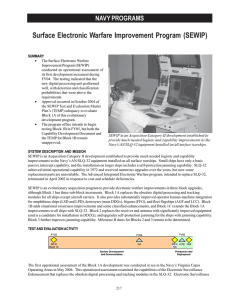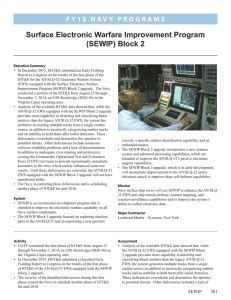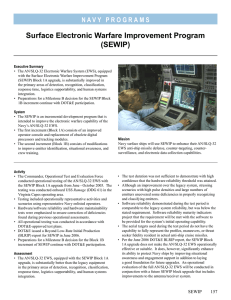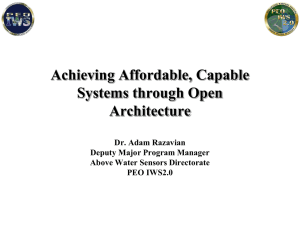Surface Electronic Warfare Improvement Program (SEWIP) Block 2
advertisement
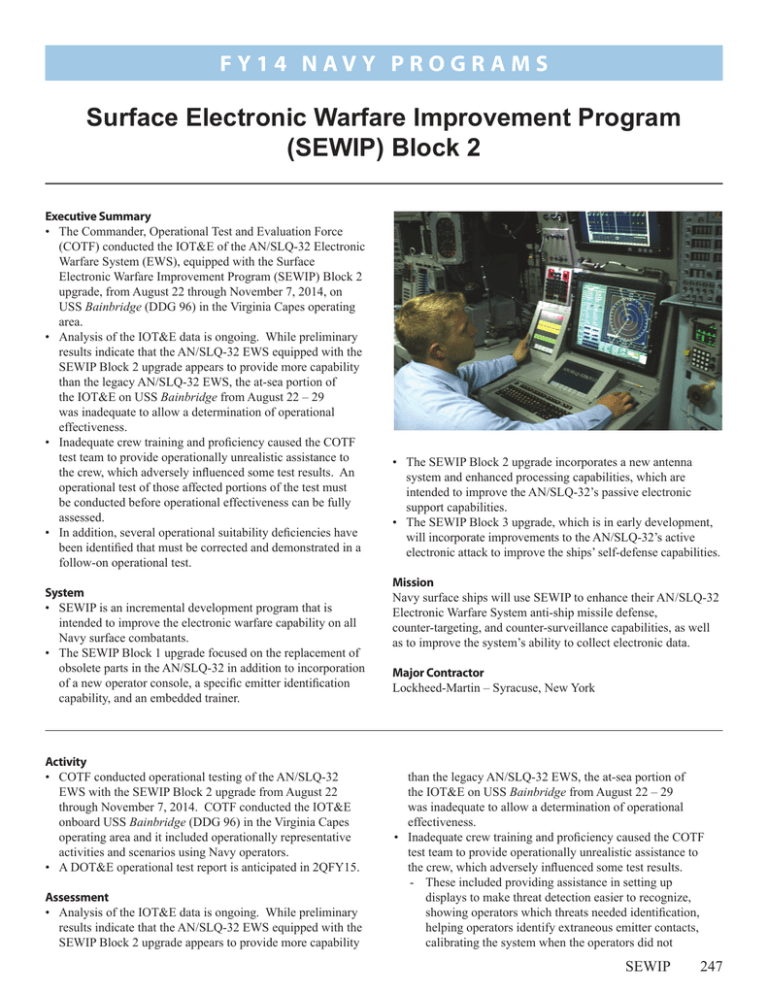
F Y14 N av y P R O G R A M S Surface Electronic Warfare Improvement Program (SEWIP) Block 2 Executive Summary • The Commander, Operational Test and Evaluation Force (COTF) conducted the IOT&E of the AN/SLQ-32 Electronic Warfare System (EWS), equipped with the Surface Electronic Warfare Improvement Program (SEWIP) Block 2 upgrade, from August 22 through November 7, 2014, on USS Bainbridge (DDG 96) in the Virginia Capes operating area. • Analysis of the IOT&E data is ongoing. While preliminary results indicate that the AN/SLQ-32 EWS equipped with the SEWIP Block 2 upgrade appears to provide more capability than the legacy AN/SLQ-32 EWS, the at-sea portion of the IOT&E on USS Bainbridge from August 22 – 29 was inadequate to allow a determination of operational effectiveness. • Inadequate crew training and proficiency caused the COTF test team to provide operationally unrealistic assistance to the crew, which adversely influenced some test results. An operational test of those affected portions of the test must be conducted before operational effectiveness can be fully assessed. • In addition, several operational suitability deficiencies have been identified that must be corrected and demonstrated in a follow-on operational test. System • SEWIP is an incremental development program that is intended to improve the electronic warfare capability on all Navy surface combatants. • The SEWIP Block 1 upgrade focused on the replacement of obsolete parts in the AN/SLQ-32 in addition to incorporation of a new operator console, a specific emitter identification capability, and an embedded trainer. Activity • COTF conducted operational testing of the AN/SLQ-32 EWS with the SEWIP Block 2 upgrade from August 22 through November 7, 2014. COTF conducted the IOT&E onboard USS Bainbridge (DDG 96) in the Virginia Capes operating area and it included operationally representative activities and scenarios using Navy operators. • A DOT&E operational test report is anticipated in 2QFY15. Assessment • Analysis of the IOT&E data is ongoing. While preliminary results indicate that the AN/SLQ-32 EWS equipped with the SEWIP Block 2 upgrade appears to provide more capability • The SEWIP Block 2 upgrade incorporates a new antenna system and enhanced processing capabilities, which are intended to improve the AN/SLQ-32’s passive electronic support capabilities. • The SEWIP Block 3 upgrade, which is in early development, will incorporate improvements to the AN/SLQ-32’s active electronic attack to improve the ships’ self-defense capabilities. Mission Navy surface ships will use SEWIP to enhance their AN/SLQ‑32 Electronic Warfare System anti-ship missile defense, counter‑targeting, and counter-surveillance capabilities, as well as to improve the system’s ability to collect electronic data. Major Contractor Lockheed-Martin – Syracuse, New York than the legacy AN/SLQ-32 EWS, the at-sea portion of the IOT&E on USS Bainbridge from August 22 – 29 was inadequate to allow a determination of operational effectiveness. • Inadequate crew training and proficiency caused the COTF test team to provide operationally unrealistic assistance to the crew, which adversely influenced some test results. - These included providing assistance in setting up displays to make threat detection easier to recognize, showing operators which threats needed identification, helping operators identify extraneous emitter contacts, calibrating the system when the operators did not SEWIP 247 F Y14 N av y P R O G R A M S perform the calibration when the system called for it, and resetting the system in the form of unscheduled warm and cold starts. - An operational test of those affected portions of the test must be conducted before operational effectiveness can be fully assessed. • Several operational suitability deficiencies that included several display freezes, system crashes, and unscheduled warm and cold starts have been identified that must be corrected and demonstrated in a follow-on operational test. Recommendations • Status of Previous Recommendations. The Navy has not resolved the following FY06 and FY08 SEWIP recommendations: 1. Review and modify the SEWIP detection and classification algorithms to correct deficiencies discovered while operating in dense pulse and emitter environments. Verify the correction of these deficiencies during future SEWIP operational test and evaluation. 248 SEWIP 2. Continue to collect in-service SEWIP hardware reliability data to gain a higher degree of confidence regarding achievement of this requirement. 3. Continue to review and modify the SEWIP software to improve its reliability. 4. Develop threat representative aerial target/threat seeker combinations and/or procure actual threat anti-ship cruise missiles for more realistic testing of future SEWIP block upgrades and other electronic warfare systems. • FY14 Recommendations. The Navy should: 1. Identify the portions of the operational effectiveness testing that were adversely affected by the operationally unrealistic assistance and schedule an additional operational test of those affected portions. 2. Correct the identified operational suitability deficiencies and schedule a follow-on operational test period to demonstrate the corrections.
